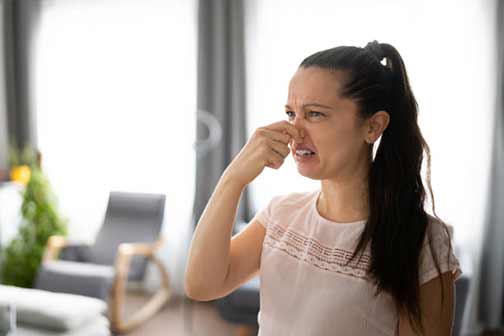
Drains that give off an offensive odor are the most embarrassing plumbing problems in your home, says Spectrum Property Management team. Even if your plumbing fixtures work just fine, if bad odors are emanating from the plumbing, you will not be comfortable using or letting others use your sinks, showers, and toilets.
What causes smelly drains in your home, and how can you solve the problem? The origins of smelly drains in your home range from the simple to the severe. Sometimes, minor adjustments in your daily habits are all you need to fix the problem; other times, you need professional intervention.
7 common causes of smelly drains in your home and their solutions
Bacteria and limescale
Bacterial growth in drainage and sewer lines can cause bad odors in your home, especially if there is a lot of organic debris in the pipes. Limescale, from the buildup of dissolved minerals in hard water, can also create a solid mass that emits rotten egg odors.
- To remove bacteria, pour chlorine bleach or hydrogen peroxide into the drain, let it sit for ten minutes, and flush with more warm water.
- To dissolve limescale, pour vinegar into the drain and let it sit overnight.
- If the problems continue, the best option is to have your drains professionally hydro jetted.
Buildup of debris
Decaying organic debris inside your drains will lead to bacterial growth and bad odors in your home. If things like grease, food particles, and hair regularly enter the drain lines, you will have this problem. To solve or prevent the problem:
- Install strainers on sink and shower drains.
- Dispose of FOG (fats, oils, and grease) and other food waste in the trash.
- Clean drains regularly by flushing the pipes with warm water and salt or have them hydro jetted them to remove any debris lodged inside the pipes.
Clogged, unused, or faulty P-traps
A P-trap is a U-shaped pipe that holds a small amount of water in its U-shaped bend to prevent gases inside your drainage lines from flowing backwards into your home. P-traps are typically found below the sink and shower. If the P-trap dries out due to disuse or becomes damaged, you will have sewage odors inside your home. Fixing this problem is easy:
- Pour water into unused P-traps to refill them
- If the problem doesn’t go away, have the P-trap checked for clogs and damage.
Blocked or damaged vents
Gases either enter your sewer line from outside or are created inside the line by the decomposition of wastewater and debris. Vent pipes are connected to your drainage system to provide a route for these gases to escape the sewer line. If these vents are damaged or blocked, you will have bad odors inside your home. Here is how to fix this problem:
- Have the vent inspected by a professional.
- If the vents are blocked by debris or bird nests, remove the blockages.
- If the vent is damaged, have a professional plumber repair it.
Sewer line problems
A cracked, leaky, or blocked sewer line can cause bad odors in your home, either by preventing the escape of sewer gases or by letting sewer gases leak into your home from the openings in the line. Sewer line issues should be properly investigated and resolved by an expert. To know if your sewer line is in trouble, look for these signs in your home:
- Multiple slow drains in the home.
- Chronic drain clogs that defy solutions.
- Fluctuating water levels in toilets.
Dirty garbage disposal
By grinding food waste into smaller particles, garbage disposals help to keep your drain lines clog-free. However, garbage disposals can also trap food waste. Organic material trapped inside the unit can decay and cause bad odors in your home. To clean your garbage disposal:
- Pour baking soda, followed by vinegar, into the unit and let it sit for 15 minutes.
- Pour warm water into the unit and run it for 60 seconds.
- Throw fresh lemon slices into the garbage disposal and grind them to freshen the unit.
Biofilm and soap scum
Biofilm is a foul-smelling and slimy thin layer of bacteria and organic materials found mostly in showers and bathroom sinks. Soap scum can trap hair and debris, combined with biofilm, to worsen the bad odors in your home. Getting rid of biofilm can be done by:
- Scrubbing the shower drain with a brush after removing the drain cover.
- Pouring baking soda and vinegar into the drain and letting them sit for at least 10 minutes.
- Using enzymatic drain cleaners to break down the bacteria.
How will you know which of these problems is the root cause of the bad odors in your home? This question highlights the importance of having your drain inspected professionally at least once a year. A proper plumbing inspection will easily reveal the causes of the smelly drains.
Furthermore, regular hydro jetting will help you prevent many of the above problems. Hydro jetting removes biofilm, buildup of soap scum, and other debris that interfere with the free flow of water inside your drainpipes. Drains that are professionally cleaned as a preventive maintenance step will not have bad odors.

